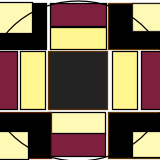Brian, Miles, Rick
Continued the vase project.
Everyone hada pretty good glue-up square.
Leo suggested taking a block plane and fair off the edges of the square.
Then use a square to find the exact center, using a scribe knife.
Then take a round block of wood to screw onto the top. Center it with a brad.
Then drill 4 holes around the periphery and screw the temporary block onto the top.
Use one colored screw (green) so as to be able to mark where the holes are for relocation and make a pencil line on the wood by the green screw.
This end is going on the tailstock.
Cut a square boss on the opposite end.
His will fit into the 4-jaw chuck.
Make it small enough to engage the chuck jaws easily (1 7/8 about)
Mount this boss onto the 4-jaw at the headstock.
Using the tool rest, turn the square by hand to see how closely it is centered. If one corner is off, remove the piece, put masking tape onto the boss at the opposite corner and re mount.
Do this repeatedly until you have your square centered.
The center the tailstock end.
Turn the square and if one corner is off, stabilize the tailstock center with a block of wood under it, then tap the wood with a mallet to move it in the proper direction.
Repeat this until the tailstock end is square.
Then you can turn the piece to a round cylinder.
Tip:
A Jarno taper is what most drill press Jacob Chucks have.

